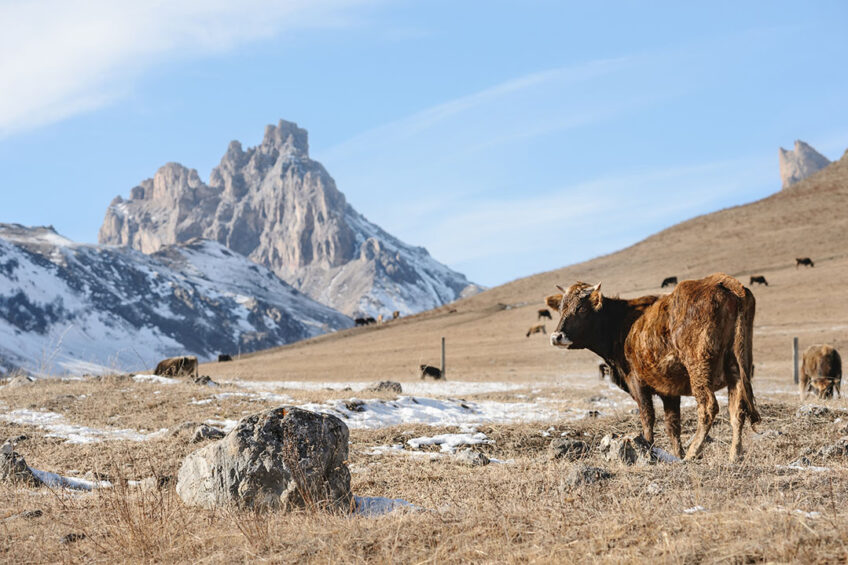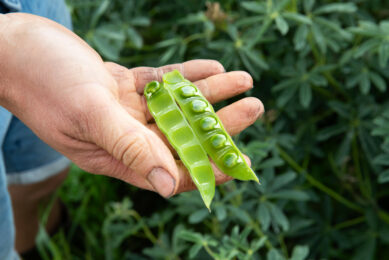What are the challenges for cows at high altitudes?

Altitude diseases in humans occur because of a lack of oxygen at high altitudes. Symptoms include headache and loss of appetite amongst others. But what about animals? Do cows that are farmed on high altitude areas also experience altitude problems?
The term “altitude” is commonly used to mean the height above sea level. The high altitude areas are characterised mainly by low atmospheric pressure and reduced air temperature. These changes occur to a varying extent depending on the magnitude of elevation and have in most cases negative effects on animal health and production unless strict feeding and management strategies are duly adopted.

Physiological response to high altitudes
There are a number of adaptive mechanisms that help the animal survive altitudes of less than 2,000 meters above sea level.
- During exposure to high altitude, animals develop several physiological responses to make it possible to live in a low oxygen environment. The increase in the number of red blood cells (RBC) and the amount of haemoglobin (Hb) are the most important haematological acclimatisation to high altitude.
- At high altitude, there is a decrease in mean cell volume (MCV), so the total surface of RBC is enlarged, which is advantageous for haemoglobin to bind oxygen, and helps prevent the increase of blood viscosity.
- The reduced environmental oxygen availability at high altitude stimulates higher respiration frequency (ventilation), which plays an important role in maintaining adequate oxygen transfer to the blood and also increases the exhalation of CO2, thereby serving to counteract the acid-base problems arising from hyperventilation.
- At high altitude, animals may also develop special mutations that alter the amino acid residues in Hb and hence increase oxygen affinity. The higher affinity, in this case, may increase oxygen saturation of blood and hence compensates for the reduced partial pressure of oxygen.
However, at higher altitudes, i.e. in mountain areas of 3,000-5000 meters above sea level, animals may encounter one or more health and production problems. This can for example be fertility problems in male animals. Some other problems are further explained in this article.
Rumen fermentation
A study was conducted to investigate the effect of 2 altitudes (3,600 and 1,600 metres) on rumen fermentation in Chinese Holstein cows. Ammonia nitrogen used for microbial protein synthesis was decreased at high altitude of 3,600 metres compared with 1,600 metres. The high altitude also affected the VFA ratio in the rumen. Thus, the acetate decreased from 64.77% at 3,600m to 63.05% at 1,600m, while the propionate increased from 19.27% at 3,600m to 24.56% at 1,600m.
Daily milk yield lower at high altitudes
A study on milk production showed that daily milk yield of cows at high altitudes was 5.6kg less than the yield at the low altitude and that it also affected milk composition due to the change of VFA ratios in the rumen, as mentioned before. With the decreased acetate-to-propionate ratio, milk fat decreases since acetate is the main precursor of milk fat synthesis. The reduction in milk fat is often associated with a reduction in milk protein but to a varying extent depending on the level of milk production. It was found that with cows producing 3,500-4000 kg of milk per year, the fat-protein correlation coefficient is +0.37, but a production level of 6,000-6,500 the correlation coefficient decreases to +0.14.
Bovine High Mountain Disease
BHMD is a result of pulmonary arterial hypertension induced by pulmonary hypoxia occurring at high altitude. Hypoxia-induced pulmonary arterial vasoconstriction and arterial hyperplasia reduce the diameter of the pulmonary arterioles, resulting in pulmonary hypertension and subsequent right ventricular (RV) hypertrophy. Without intervention to reduce the hypoxia-induced pulmonary hypertension, the disease will eventually progress to RV congestive/dilatory cardiac failure. The incidence in cattle on high-mountain pastures averages 3%–5% but has been as much as 65% in genetically susceptible calves. The disease usually develops slowly over several weeks, commonly within the first 3 to 4 weeks after cattle are moved from lower to higher elevations. Affected animals initially appear depressed and reluctant to move. As the syndrome progresses, sub-acute oedema develops in the brisket region and extends cranially to the inter-mandibular space and caudally to the ventral abdominal wall. Pleural effusion and ascites are usually abundant. Profuse diarrhoea may develop as a result of intestinal venous hypertension. Respiration is laboured, and severely affected animals may collapse and die.
Hypothermia
The temperature drops about 0.6°C for every 100 metres. increase above sea level. Thus at 4,500 metres, it should theoretically be 27°C cooler than at sea level. Mountainous regions near the tropics experience a gradient of climates that can be divided into the Arctic, cold, sub-cold, moderate and warm, according to altitude. The environmental temperature at which the cow will begin to experience hypothermia will vary. Short hair coats, high winds, and wet cattle will amplify the actual environmental temperature and induce hypothermia sooner. As hypothermia sets in, all metabolic and physiologic processes begin to slow. Blood is shunted away from the extremities in an attempt to protect vital organs. As hypothermia progresses, the heart rate decrease and blood pressure drops. Eventually, the cow loses consciousness and death is imminent if rewarming does not occur.
Frostbite
Frostbite of the teats can be a serious consequence of cold exposure at high altitudes. Once frostbite occurs, very little can be done to revitalise the tissues. Rapid thawing of the tissue is preferable and less painful than gradual thawing. If the teat end is devitalised, these cattle should be watched closely for mastitis at calving.
Calves
The calf has very little fat reserve, is born with a wet hair coat, and does not have the benefit of a functioning rumen to generate heat. Calves can go through the stages of hypothermia quickly and if rewarming does not occur death cannot be avoided. Cows expected to calve in extreme weather must be given shelter or be under constant surveillance to prevent calf loss from hypothermia.
Feeding and management strategies
The low nutritive value of high-altitude feeds should prompt proper conservation and application of known chemical and physical treatment methods to improve digestibility and utilisation. Diets should also be supplemented with antioxidants such as vitamin E. It is also important to supply adequate amounts of iron at high altitudes where atmospheric pressure is lower and there is less oxygen in each breath. Animals affected by BHMD should be moved to a lower altitude with minimal restraint, stress, and excitement. General supportive therapy, including diuretics, thoracocentesis, antibiotics, and appetite stimulant such as vitamin B complex, may be beneficial. Thoracocentesis is the single treatment that most dramatically improves an affected animal’s chance of survival. At high elevations, use of oxygen or a hyperbaric chamber may be considered for valuable animals. Treatment of BHMD can be expensive and unrewarding, so prevention is preferred. Genetic selection through the use of pulmonary arterial pressure (PAP) measurements to select cattle resistant to the effects of hypoxia is a more effective way to control BHMD.
References are available on request.
Join 13,000+ subscribers
Subscribe to our newsletter to stay updated about all the need-to-know content in the dairy sector, two times a week.










